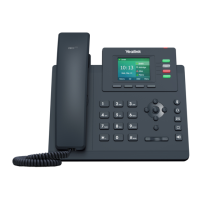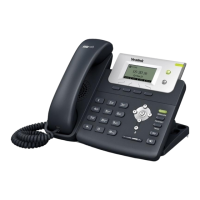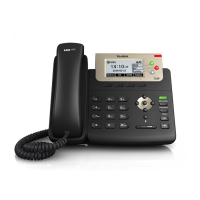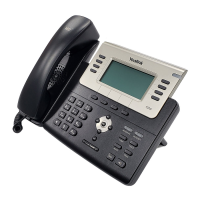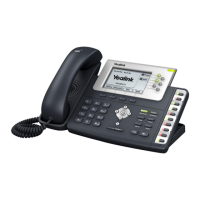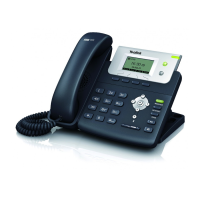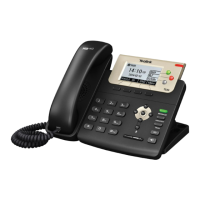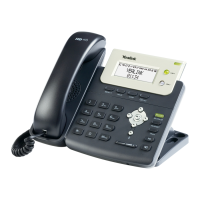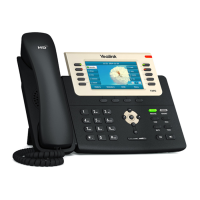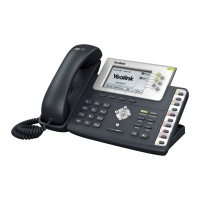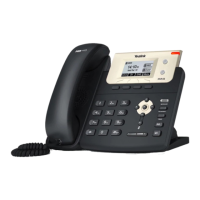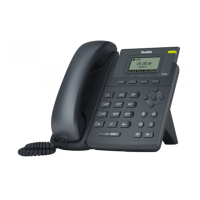Do you have a question about the Yealink SIP-T20 and is the answer not in the manual?
| Lines | 2 |
|---|---|
| Network | 10/100 Mbps Ethernet |
| Wall Mountable | Yes |
| Operating Humidity | 10% to 90% (non-condensing) |
| Display | 132 x 64 pixel graphical LCD |
| Audio Codec | G.711, G.722, G.729A |
| Power Supply | Power over Ethernet (PoE) |
| Features | Call hold, mute, call forward, call waiting, call transfer, redial, volume control |
| Protocols Supported | SIP, HTTP, DHCP, TCP/IP/UDP, TFTP, DNS |
| Ethernet Ports | 2 (10/100 Mbps) |
| Dimensions | 200mm |
| Operating Temperature | 0 ~ 40°C |
| Certifications | CE, FCC, RoHS |
Details the main hardware components of the SIP-T20P/SIP-T20 IP phone, including the LCD screen and keypad.
Describes the icons that appear on the LCD screen and their meanings for phone operation.
Explains the status indications provided by the Power Indicator LED and Line key LED.
Outlines the two ways to customize phone configurations: via the IP phone interface and via a web browser.
Details how to access and use the IP phone's interface for configuration and call operations.
Explains how to access and utilize the web browser interface for comprehensive phone configuration.
Lists the available documentation for the SIP-T20P/SIP-T20 IP phone, including where to find them.
Lists all the components included in the SIP-T20P/SIP-T20 IP phone package.
Provides instructions on how to physically install the phone, including attaching the stand and connecting cables.
Describes the automatic phone initialization process and DHCP settings upon first power-up.
Explains how to view the phone's system status, including network and account information.
Guides users on manually configuring network settings like IP address if DHCP is not available.
Explains the process of registering the phone with the network for use.
Describes the information displayed on the phone's screen when it is idle.
Covers basic phone customization options like language, time, date, and administrator password.
Instructions for changing the phone's user interface language.
Details on configuring the phone's time, date, and SNTP settings.
Guidance on changing the default administrator password for enhanced security.
Instructions on configuring the '#' or '*' key to function as the send key for dialing.
Explains how to lock the phone's keypad to prevent unauthorized use.
Covers customization of audio parameters, including volume and ring tones.
Details on adjusting the ringer volume and receiver volume for the phone.
Instructions for selecting and customizing ring tones for incoming calls.
Provides instructions for managing contacts, including local directories and blacklists.
Guides on adding, editing, deleting, and managing contacts in the phone's local directory.
Details on adding and managing contacts in the blacklist to block unwanted calls.
Explains how to view, manage, and utilize call history entries.
Covers system-level customizations available for the IP phone.
Instructions on customizing the text logo displayed on the phone's idle screen.
Information on connecting and activating the headset for phone usage.
Explains the configuration and usage of Direct Station Selection (DSS) keys.
Details on assigning predefined functionalities to the line keys for quick access.
Guidance on customizing navigation, HOLD, CONF, and TRAN keys on the keypad.
Covers managing phone accounts, including registration and association with line keys.
Step-by-step instructions for registering SIP accounts on the IP phone.
Explains the dial plan features for processing keypad inputs and call routing.
Details on configuring rules to replace strings for dialing numbers.
Instructions for setting up rules that automatically dial numbers upon matching input.
Guidance on configuring area codes for dialing numbers outside local areas.
Instructions for adding numbers to block specific outgoing calls.
Details on specifying emergency numbers for quick dialing in urgent situations.
Explains how to enable the live dialpad for automatic number dialing.
Instructions for configuring the hotline feature for automatic dialing upon lifting handset.
Guides on how to place calls using the handset, speakerphone, or headset.
Details on how to answer incoming calls when the phone is idle or during an active call.
Instructions on how to terminate an active call using different phone modes.
Explains how to redial the last dialed number or select from call history.
Details on configuring the phone to automatically answer incoming calls.
Instructions on enabling and configuring automatic redial for busy or unanswered calls.
Explains how to set up call completion to notify the caller when the callee becomes available.
Details on configuring a key to place a call back to the last incoming call.
Instructions on muting and un-muting the microphone during an active call.
Guides on placing an active call on hold and resuming a held call.
Explains how to activate/deactivate DND mode to reject incoming calls.
Details on configuring static call forwarding modes: Always, Busy, and No Answer.
Describes the three types of static call forwarding: Always, Busy, and No Answer.
Provides instructions for performing blind, semi-attended, and attended call transfers.
Explains how to enable/disable call waiting to receive calls during an active call.
Details on setting up local and network conference calls with multiple participants.
Guides on setting up a conference call using the phone's local conference feature.
Explains how to conduct a conference call using the network conference feature.
Details on placing a call on hold and retrieving it from another phone.
Describes directed and group call pickup for answering incoming calls for others.
Instructions for configuring a key to pick up a call ringing at a specific phone number.
Guides on configuring a key to pick up any incoming call within a defined group.
Explains how to block caller identification for outgoing calls.
Details on automatically rejecting incoming calls from anonymous callers.
Details on configuring a BLF key to monitor the status of a friend's line.
Instructions on configuring keys to record calls using 'Record' or 'URL Record' methods.
Explains how to use hot desking to log out existing accounts and log into new ones.
Guides on configuring and using the intercom feature for office communication.
Details on configuring a key for making outgoing intercom calls.
Explains features for automatically answering incoming intercom calls.
Details on configuring keys for sending and receiving multicast paging streams.
Instructions on configuring the phone to send multicast RTP streams.
Guides on configuring the phone to receive multicast RTP streams.
Details on configuring the music on hold server for calls placed on hold.
Explains how to configure and use the ACD system for call center operations.
Covers features related to messages, including voice mail and MWI.
Details on leaving and listening to voice mails on the IP phone.
Explains how the message waiting indicator functions and how to configure it.
Troubleshooting steps for a blank LCD screen on the IP phone.
Steps to resolve the 'Network Unavailable' message on the phone.
Troubleshooting steps for issues related to not getting a dial tone.
Common reasons and checks for not being able to receive calls on the IP phone.
Procedure for resetting the IP phone to factory default settings.
Information regarding service agreements applicable to the Yealink product.
Legal disclaimer outlining Yealink's liability for product use and performance.
Essential safety precautions to reduce risks of fire, electrical shock, and personal injury.
Guidelines for placing and operating the device in suitable environmental conditions.
Precautions and requirements for safe operation, handling, and power usage of the device.
Instructions on how to safely clean the device.
